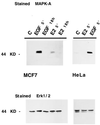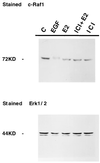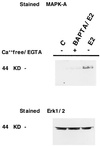Estrogen-induced activation of mitogen-activated protein kinase requires mobilization of intracellular calcium
- PMID: 10200323
- PMCID: PMC16393
- DOI: 10.1073/pnas.96.8.4686
Estrogen-induced activation of mitogen-activated protein kinase requires mobilization of intracellular calcium
Abstract
Estrogens and growth factors such as epidermal growth factor (EGF) act as mitogens promoting cellular proliferation in the breast and in the reproductive tract. Although it was considered originally that these agents manifested their mitogenic actions through separate pathways, there is a growing body of evidence suggesting that the EGF and estrogen-mediated signaling pathways are intertwined. Indeed, it has been demonstrated recently that 17beta-estradiol (E2) can induce a rapid activation of mitogen-activated protein kinase (MAPK) in mammalian cells, an event that is independent of both transcription and protein synthesis. In this study, we have used a pharmacological approach to dissect this novel pathway in MCF-7 breast cancer cells and have determined that in the presence of endogenous estrogen receptor, activation of MAPK by E2 is preceded by a rapid increase in cytosolic calcium. The involvement of intracellular calcium in this process was supported by the finding that the presence of EGTA and Ca2+-free medium did not affect the activation of MAPK by E2 and, additionally, that this response was blocked by the addition of the intracellular calcium chelator 1,2-bis(2-aminophenoxy)ethane-N,N,N',N'-tetraacetate. Cumulatively, these data indicate that the estrogen receptor, in addition to functioning as a transcription factor, is also involved, through a nongenomic mechanism, in the regulation of both intracellular calcium homeostasis and MAPK-signaling pathways. Although nongenomic actions of estrogens have been suggested by numerous studies in the past, the ability to link estradiol and the estrogen receptor to a well defined signaling pathway strongly supports a physiological role for this activity.
Figures






Similar articles
-
Estrogen-induced activation of Erk-1 and Erk-2 requires the G protein-coupled receptor homolog, GPR30, and occurs via trans-activation of the epidermal growth factor receptor through release of HB-EGF.Mol Endocrinol. 2000 Oct;14(10):1649-60. doi: 10.1210/mend.14.10.0532. Mol Endocrinol. 2000. PMID: 11043579
-
Estrogen action via the G protein-coupled receptor, GPR30: stimulation of adenylyl cyclase and cAMP-mediated attenuation of the epidermal growth factor receptor-to-MAPK signaling axis.Mol Endocrinol. 2002 Jan;16(1):70-84. doi: 10.1210/mend.16.1.0758. Mol Endocrinol. 2002. PMID: 11773440
-
17-Beta-estradiol inhibits transforming growth factor-beta signaling and function in breast cancer cells via activation of extracellular signal-regulated kinase through the G protein-coupled receptor 30.Mol Pharmacol. 2008 Dec;74(6):1533-43. doi: 10.1124/mol.108.046854. Epub 2008 Sep 3. Mol Pharmacol. 2008. PMID: 18768737
-
Membrane estrogen receptor-dependent extracellular signal-regulated kinase pathway mediates acute activation of endothelial nitric oxide synthase by estrogen in uterine artery endothelial cells.Endocrinology. 2004 Jan;145(1):113-25. doi: 10.1210/en.2003-0547. Epub 2003 Sep 25. Endocrinology. 2004. PMID: 14512434
-
Estradiol-induced phosphorylation of serine 118 in the estrogen receptor is independent of p42/p44 mitogen-activated protein kinase.J Biol Chem. 1998 May 22;273(21):13317-23. doi: 10.1074/jbc.273.21.13317. J Biol Chem. 1998. PMID: 9582378
Cited by
-
Diabetes alters intracellular calcium transients in cardiac endothelial cells.PLoS One. 2012;7(5):e36840. doi: 10.1371/journal.pone.0036840. Epub 2012 May 9. PLoS One. 2012. PMID: 22590623 Free PMC article.
-
Importance of sex to pain and its amelioration; relevance of spinal estrogens and its membrane receptors.Front Neuroendocrinol. 2012 Oct;33(4):412-24. doi: 10.1016/j.yfrne.2012.09.004. Epub 2012 Oct 2. Front Neuroendocrinol. 2012. PMID: 23036438 Free PMC article. Review.
-
Mitogen-activated protein kinase is involved in the progesterone-mediated induction of baboon glycodelin.Endocrine. 2006 Feb;29(1):121-7. doi: 10.1385/endo:29:1:121. Endocrine. 2006. PMID: 16622300
-
A link between plasma membrane calcium ATPase 2 (PMCA2), estrogen and estrogen receptor α signaling in mechanical pain.Sci Rep. 2018 Nov 22;8(1):17260. doi: 10.1038/s41598-018-35263-0. Sci Rep. 2018. PMID: 30467368 Free PMC article.
-
Estrogen receptor transcription and transactivation: Estrogen receptor alpha and estrogen receptor beta: regulation by selective estrogen receptor modulators and importance in breast cancer.Breast Cancer Res. 2000;2(5):335-44. doi: 10.1186/bcr78. Epub 2000 Jul 7. Breast Cancer Res. 2000. PMID: 11250726 Free PMC article. Review.
References
-
- O’Malley B W, Tsai S Y, Bagchi M, Weigel N L, Schrader W T, Tsai M-J. Recent Prog Horm Res. 1991;47:1–26. - PubMed
-
- Batra S. Eur J Pharmacol. 1986;127:37–42. - PubMed
-
- Morley P, Whitfield J F, Vanderhyden B C, Tsang B K, Schwartz J L. Endocrinology. 1992;131:1305–1312. - PubMed
-
- DiAgustine R P, Petruez P, Bell G I, Brown C F, Korach K S, McLachlan J A. Endocrinology. 1988;122:2355–2363. - PubMed
Publication types
MeSH terms
Substances
Grants and funding
LinkOut - more resources
Full Text Sources
Other Literature Sources
Miscellaneous

